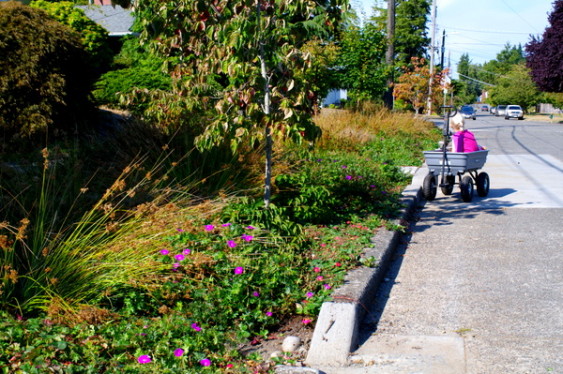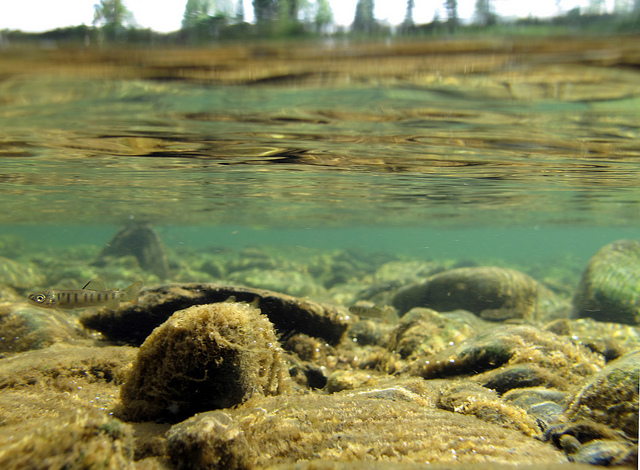Editor’s note: Planning on installing a rain garden this year? This popular article from last winter should give you that added boost of encouragement to take the plunge! (Our salmon will thank you.) More resources here, too!
When Northwest scientists collected rainwater runoff from Seattle’s Highway 520 and exposed juvenile salmon to the stormwater, all of the fish were dead within 12 hours.
But if they first treated the stormwater by running it through a column containing primarily sand, compost, and shredded bark—essentially a mini rain garden—the coho survived.
The researchers repeated the test with tiny crustaceans and mayfly nymphs, a favorite food of juvenile salmon. Again, the untreated water proved deadly while filtration through the faux rain garden removed enough pollution that the creatures survived.
“This is a simple approach that can make a big difference in the quality of water flowing into our rivers and streams,” said Jennifer McIntyre, postdoctoral researcher at Washington State University and lead author of the research, which is being published this month in the journal Chemosphere.
“In this case, the salmon and their prey are telling us how clean is clean enough,” said McIntyre in press release.
When rain falls on roadways, parking lots, and rooftops, it can’t soak into these hard surfaces, so it streams across them, picking up oil and grease, heavy metals, pesticides, and other toxic chemicals. It carries the pollutants into streams and gutters that flow directly into Puget Sound and other sensitive waterways.

Green stormwater solutions, including rain gardens and bioswales (rain gardens’ more heavily engineered cousins), absorb the runoff, reducing the volume of stormwater and stripping the pollution out of it.
McIntyre and other researchers found that by filtering the runoff through the columns it reduced the amount of metals in the water by 30 to 99 percent. Polycyclic aromatic hydrocarbons (PAHs), created by the combustion of gasoline, wood, and other fossil fuels, were largely eliminated. The results corroborate earlier research showing that soil, bacteria, sand, plants, and other elements of rain gardens capture and treat many of the pollutants.
[prettyquote align=”right”]Filtering #stormwater runoff reduces its metals content by 30-99%.[/prettyquote]
“The positive effects on survival are really striking,” said Nat Scholz, manager of the Ecotoxicology Program at NOAA Fisheries’ Northwest Fisheries Science Center and a coauthor of the research, in a press release. “This is an encouraging lesson for people working to reduce stormwater impacts to salmon habitats.”
Across the Northwest there is a movement to install more rain gardens and green stormwater technologies, which also include green roofs and permeable pavement, as well as protecting native vegetation and shrinking the amount of water-repelling impervious surfaces being built. In Washington, the state Department of Ecology has rules for cities and counties that require the increased use of green solutions while the voluntary 12,000 Rain Gardens program encourages private landowners to manage their stormwater.
The columns used to treat the runoff in the experiments measured roughly 14 inches in diameter and contained a two-feet-deep soil mixture that was 60 percent sand, 15 percent compost, 15 percent shredded bark and 10 percent drinking-water treatment residuals from the nearby city of Anacortes. The sand component helps with the drainage and filtering, while the compost provides nutrients needed by plants and trees and can help capture pollutants. Underneath the soil mixture was about a foot of gravel for drainage. Half of the 12 columns were planted with sedges, though the grassy plants didn’t appear to have much effect on the results.
The columns are a fair approximation of a Northwest rain garden. In Washington, the state’s official rain garden guide and its 2012 LID Technical Guidance Manual for Puget Sound include recommendations for the “bioretention soil mix” used in rain gardens. The mix calls for 60 to 65 percent sand or soil excavated from the site, and 35 to 40 percent compost.
The study’s authors concluded that their experiments provide a scientifically sound endorsement of green stormwater solutions, stating:
Overall, these results demonstrate that bioretention can achieve a central aim of green stormwater infrastructure; namely, preventing harm to aquatic animals.


Comments are closed.